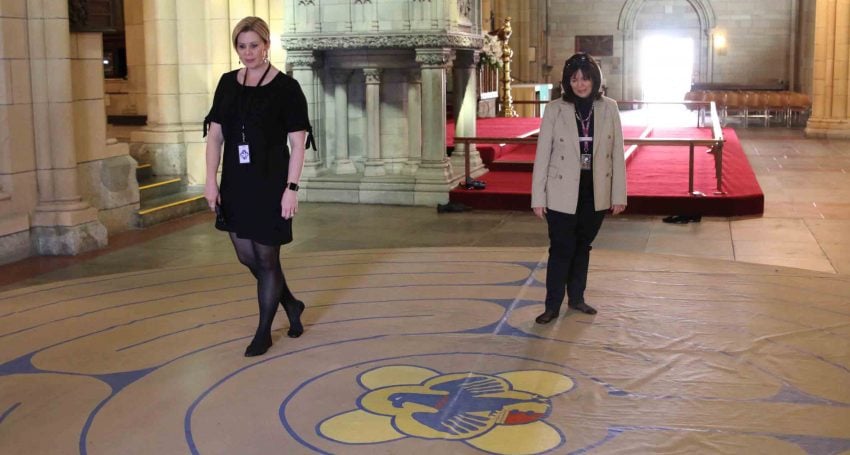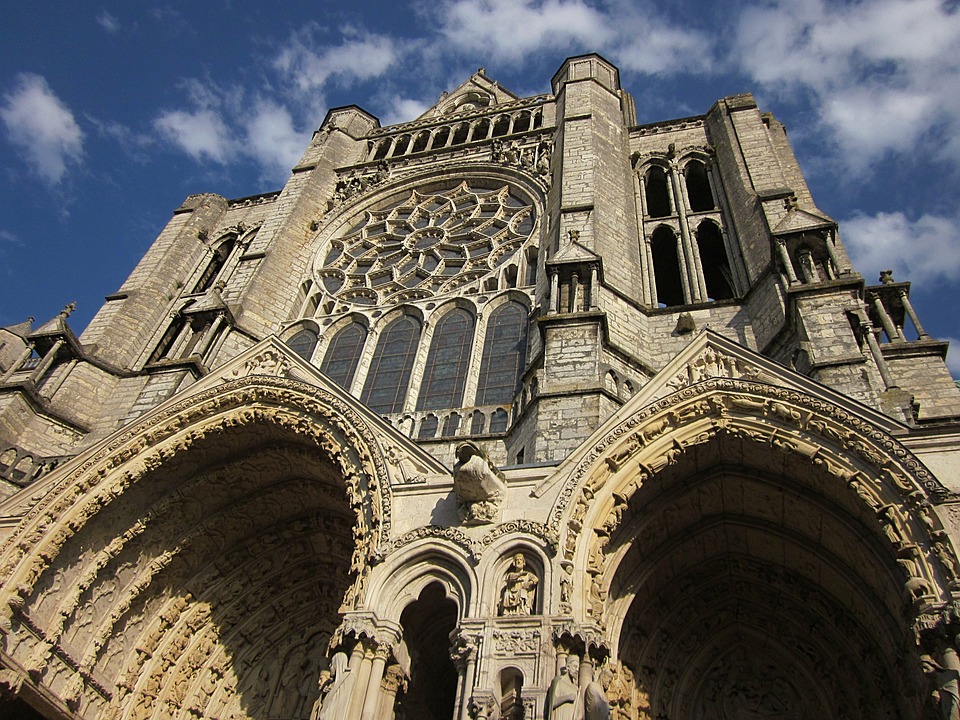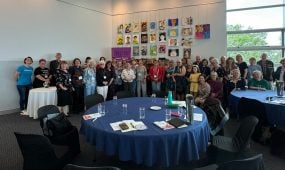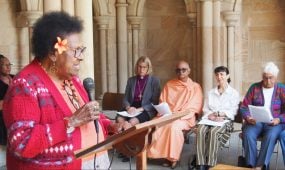Labyrinths: ancient practice, Anglican renaissance
Reflections
Over the last 15 years or so, the ancient meditative practice of labyrinth walking has been gaining momentum across our Diocese: Randal Dennings, from St Matthew’s Church in Holland Park, introduces us to the history of labyrinths and local labyrinth activities

St John’s Cathedral visitors often stop and puzzle over the labyrinth they encounter on the floor just in front of the Lady Chapel and wonder, “What is this strange circular design ‘carpet’…and what is it doing here in this sacred place?”
The labyrinth symbolises the journey of the soul to the divine, inviting us to walk with God: “Thus says the Lord: Stand at the crossroads, and look, and ask for the ancient paths, where the good way lies; and walk in it, and find rest for your souls.” (Jeremiah 6.16)
Advertisement
The Anglican Labyrinth Resource Group (ALRG) is a group of local Anglicans who, under the patronage of Bishop Jeremy Greaves, have come together to initiate and develop a Diocesan labyrinth ministry, developing and sharing resources with parishes, schools and other ministries. Since there are many Anglican labyrinths and labyrinth walkers within our Diocese, the decision was made early last year to bring together local Anglicans active or interested in labyrinth ministry under the umbrella of the ALRG, so that existing and emerging labyrinth ministries can be better supported.
Christine Gourlay, leading ALRG member and coordinator of our Cathedral’s monthly Labyrinth walks, tells us more about the history and purpose of the labyrinth:
“The Labyrinth appears in many cultures and faith traditions throughout the world. It was adopted into the Christian tradition at least as early as the fourth Century and by the Middle Ages many were installed in Cathedrals and churches throughout Europe, often upon pilgrimage routes. Back in the Middle Ages it was often difficult to make a pilgrimage all the way to the Holy Land. So, instead, people would make a pilgrimage to one of the ‘pilgrimage’ cathedrals or churches with a labyrinth. Labyrinths have again flourished in the late 20th century and are currently being installed in a variety of locations including churches, hospitals, schools and gardens. The St John’s Cathedral Labyrinth is based upon that of Chartres Cathedral, which has been continuously walked since the 1200s. Our labyrinth was designed by leading artist Cedar Priest and has at its centre the eagle, which is the symbol of St John.”

Chartres Cathedral, France
Another question St John’s Cathedral visitors often ask is “What is the difference between a labyrinth and a maze?” Our patron, Bishop Jeremy Greaves, contrasts mazes and labyrinths by saying:
“A maze is designed so that you are tricked and confronted by choices – you are challenged to discover the maze’s centre. A labyrinth has only one path and no tricks – simply a winding path to its centre. In fact, the labyrinth has become for many a helpful spiritual tool to help us all find our own centre – the person we were called forth by God to be.”
Advertisement
St John’s Cathedral visitors sometimes also query what spiritual benefit can be derived from merely ‘walking in circles’? The Rev’d Penny Jones, another leading ALRG member and Director of Formation at St Francis College, reminds us that:
“Our bodies are a key part of our traditional Anglican prayer and worship – we kneel, stand or walk in procession. We also often use spiritual tools to aid our prayer, worship and meditation, such as icons, religious paintings and vigils. Praying whilst walking a labyrinth is just another spiritual tool to quieten our minds and open our hearts to the divine. The labyrinth provides a safe path, a time away from the ‘busy-ness’ of our daily lives to renew our connectedness with God. Walking the labyrinth is a metaphor of our own spiritual pilgrimage and life journey. The one path winds its way towards the centre – walking with and towards the Divine – a pilgrimage in miniature reflecting the twists and turns in life’s journey.”
Vanessa Gamack, Anglican Schools Commission’s Education and Mission Advisor, elaborates on the spiritual benefits of labyrinth mediation and how this unique ministry can be used to help connect people who are not ‘churched’:
“I love promoting labyrinth spirituality – particularly within our schools. Within the Church, and within our schools, we sometimes struggle to find common ground with those who are not regular worshippers. We often can’t seem to find something that is non-threatening, attractive to seekers yet meets everyone ‘where they are’. Yet, labyrinths do just this…everyone is seeking for a little more space in their lives away from all the rush and hustle and bustle. You don’t need to sign onto any doctrine nor make any commitment ‘upfront’…simply just provide the opportunity and let them walk and take time to be alone with God. The Holy Spirit does the ‘heavy lifting’. I see the labyrinth as a ‘bridge’ for our Diocese to engage with those seekers outside the church…and provide a welcoming, hospitable and safe place for all to explore, go deeper and grow closer to Jesus.”

Churchie students seeking space and solitude in a labyrinth
The ALRG has been busy responding to the increasing interest within our Diocese to explore labyrinth ministry and spirituality further. Some of our recent activities include providing labyrinth walks and workshops for parishes and meditation and EfM groups; supporting the Anglican and Ecumenical Prison Chaplains in-service training sessions and working with Chaplains to introduce labyrinth spirituality into Queensland prisons; providing support to Anglican school teachers and Chaplains via an Anglican Schools Commission in-service training day; providing labyrinth prayer spaces at key Diocesan events; running this year’s Brisbane World Labyrinth Day; supporting St Luke’s Toowoomba Carnival of Flowers celebrations; and, providing a labyrinth ‘incursion’ for Churchie Grade 4 boys with Chaplain Steph Cotroneo and Anglican Schools Commission’s Vanessa Gamack.

Labyrinth family fun at St Luke’s, Toowoomba during the Carnival of Flowers September 2018
You are warmly invited to attend one of the Anglican Labyrinth Resource Group regular walks, which are held on the first Sunday of the month after the 9.30am service at the Cathedral or at St Matthew’s, Holland Park after the 9am service on 29 September and 24 November.
You are also welcome to join us on one of these upcoming training days:
Brisbane venue: At St Francis College, Milton on 28 September between 10 am and 2 pm, Please BYO lunch and drinks. This is a free event. Please RSVP by contacting ALRG Coordinators Susan and Randal Dennings on 0408 878711 or via email.
Kingscliff venue: At St James Anglican Church, 122 Marine Parade Kingscliff (just south of Tweed Heads / Gold Coast) on 24 August and 26 October between 12 noon and 2.30 pm (if you can come earlier, Fr Greg March will be also hosting a community walk from 10 am on these days). Please RSVP by contacting ALRG Coordinators Susan and Randal Dennings on 0408 878711 or via email.
If you would like to find out more, please feel free to contact the ALRG Coordinators Susan and Randal Dennings.





